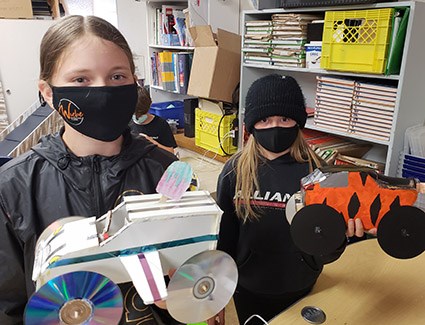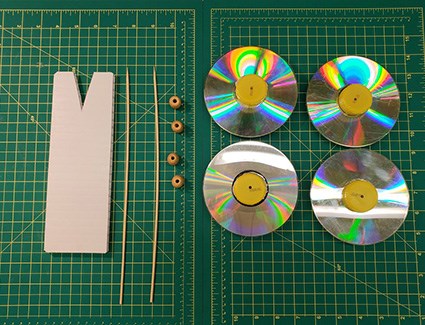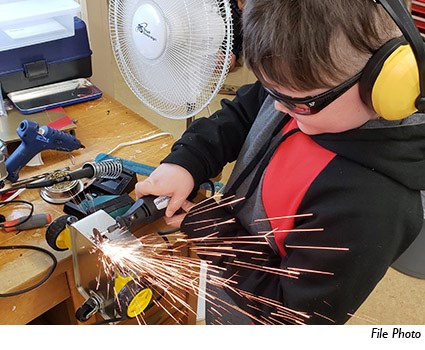 The students at Montgomery School like other people's leftovers.
The students at Montgomery School like other people's leftovers.
Cardboard, compact discs and DVDs, outdated electronics, and a variety of other obsolete or unused materials are repurposed for hands-on experiences as part of a creative approach to science, math, art, and practical and applied arts learning that takes place in the school's makerspace lab under the guidance of teacher David Crowell.
"Our work in how we meet science and PAA and career outcomes is a combined approach commonly referred to as maker education. Maker education is simply defined as: hands-on and learner-driven," Crowell told trustees during the Celebrating Excellence portion of a recent Board of Education meeting.
Using a maker approach to meet curricular outcomes has been a popular approach at Montgomery School for several years. Recently, Crowell and his students are sharing their experiences by developing STEM education kits that offer middle years students and teachers at other schools the opportunity to apply a low-cost, maker-style approach to their learning.
The kit concept is a direct result of the COVID-19 pandemic. Crowell adapted his program for Montgomery students by creating individual kits stocked with the necessary tools and materials as a way to limit sharing among students. The loaner kit program aims to provide hands-on learning tasks and activities to classroom teachers at other schools who may not possess the expertise, time, or budget to create these experiences themselves.
The kits, which received funding from the Saskatoon Public Schools Foundation's Programs of Excellence grant, contain individual learning materials for up to 30 students along with companion documents to assist with achieving learning outcomes in science, mathematics, art, career education and PAA for Grade 5-8 classrooms. Montgomery's middle years students assist with developing and maintaining the kits as part of their Career Education curriculum.
"There is an education component for the staff member too. The idea is to share ideas using low-cost items that they can make with materials they have around them," said Crowell, who welcomes the opportunity to share the experiences he and his students have shared with this approach to learning.
"We are working on an optics kit where you just need an old CD that you put in hot water and then cut with scissors, and you can make a spectroscope, which allows you to basically look at the blueprint — the spectrum — of light while covering multiple outcomes in the Grade 8 optics unit."
 The loaner kit program is working with partner classrooms at James L Alexander, Brevoort Park, John Lake, and Silverspring schools during the current school year. The goal will be to develop at least one loaner per grade level from Grades 5 to 8. Each kit will cover at least one science learning outcome along with additional outcomes in mathematics, art, career education, and practical and applied arts.
The loaner kit program is working with partner classrooms at James L Alexander, Brevoort Park, John Lake, and Silverspring schools during the current school year. The goal will be to develop at least one loaner per grade level from Grades 5 to 8. Each kit will cover at least one science learning outcome along with additional outcomes in mathematics, art, career education, and practical and applied arts.
Kit examples include a DVD-wheel derby car that pairs with a Grade 5 science unit on simple machines; a bin dealing with static electricity and DC circuits for Grade 6; a soil analysis kit to fit with the Grade 7 Earth's crust and resources unit; and construction of a camera obscura for a Grade 8 unit on optics.
"Our hope is that we are going to lend you the kit once, and then hopefully build the capacity where you realize you don't have to get the kit from us in the future," Crowell said.
Beyond the kits, maker education takes several forms at Montgomery, including a tinkering-to-learn approach that includes an electronics dissection program for lower grades during indoor recesses where students take screwdrivers in hand to investigate the inner workings of outdated technology.
"We have fabulous donors that bring us all kinds of things to tear apart, and kids just love going in there and tinkering and learning what makes the things inside tick," Crowell said.
The opportunity to use real-world tools and the hands-on opportunities in woodcraft and techniques such as soldering as part of practical and applied arts learning creates a connection with students.
Carly, a Grade 6 student, told trustees that the projects she has done have been a hit with her parents, and what she's learned has given her perspective on opportunities for the future.
"It definitely opens up a bunch of different paths that I can pursue. Even if I don't, the skills will certainly help me and they can even become hobbies," she said.
 Tristan Bosovich, a Grade 8 student, used the skills he learned to make Christmas presents for his parents. Working on projects that involve using a saw or creating sparks while using a Dremel tool have also sparked interest for high school learning and possible careers.
Tristan Bosovich, a Grade 8 student, used the skills he learned to make Christmas presents for his parents. Working on projects that involve using a saw or creating sparks while using a Dremel tool have also sparked interest for high school learning and possible careers.
"I hope in the future I can do something like this in my every day job," he said. "That would be fun."
For Crowell, a big indicator of the success in the maker-style approach to learning is students' pride in their projects.
"You can see the excitement in the students' faces as they showcase their projects. I tell them I don't want to see them abandoned in the schoolyard, or the recycle bin. It's hard to collect samples of student work as most want to take them home," he said. "And then the most important thing is it makes them want to learn more — I think that is our Number 1 goal."